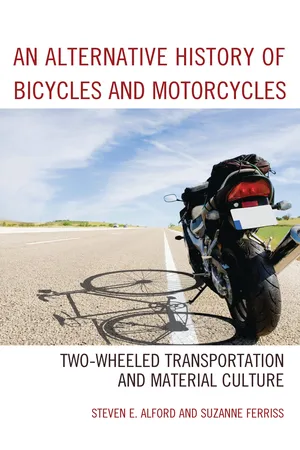
eBook - PDF
An Alternative History of Bicycles and Motorcycles
Two-Wheeled Transportation and Material Culture
- 201 pages
- English
- PDF
- Available on iOS & Android
eBook - PDF
An Alternative History of Bicycles and Motorcycles
Two-Wheeled Transportation and Material Culture
About this book
An Alternative History of Bicycles and Motorcycles: Two-Wheeled Transportation and Material Culture accounts for the nineteenth-century creation and development of two-wheeled vehicles, both human-powered and motorized. Specifically, the book focuses on the period from 1885 (which saw the appearance, simultaneously, of the Safety bicycle and the Einspur, the first motorcycle) to 1920, while exploring implications for later bicycling and motorcycling. We argue that invention of these vehicles, rather than the product of gifted individuals, should be seen as the consequence of a number of historical, economic, cultural and political forces that intersect so unpredictably that the notion of a genius inventor is reductive.
The common evolutionary model of development from the bicycle to the motorcycle oversimplifies both the technology and its origins. Stripping the vehicles of all their material and cultural associations, such a model fails to advance our understanding of the devices, their creators, and their riders. Taking a contemporary vehicle and tracing its lineage creates a false sense of evolutionary necessity in its creation, and fails to account for the many possible developmental paths that were, for whatever reason, abandoned. By contrast, our book adopts a material culture approach, a form of inquiry that stresses the connections between artifacts and social relations. We consider not simply the bicycle and motorcycle as material objects but focus also on the complex socio-political and economic convergences that produced the materials, materials that in turn themselves shaped the vehicles' appearance, function, and adoption by riders.
The common evolutionary model of development from the bicycle to the motorcycle oversimplifies both the technology and its origins. Stripping the vehicles of all their material and cultural associations, such a model fails to advance our understanding of the devices, their creators, and their riders. Taking a contemporary vehicle and tracing its lineage creates a false sense of evolutionary necessity in its creation, and fails to account for the many possible developmental paths that were, for whatever reason, abandoned. By contrast, our book adopts a material culture approach, a form of inquiry that stresses the connections between artifacts and social relations. We consider not simply the bicycle and motorcycle as material objects but focus also on the complex socio-political and economic convergences that produced the materials, materials that in turn themselves shaped the vehicles' appearance, function, and adoption by riders.
Frequently asked questions
Yes, you can cancel anytime from the Subscription tab in your account settings on the Perlego website. Your subscription will stay active until the end of your current billing period. Learn how to cancel your subscription.
At the moment all of our mobile-responsive ePub books are available to download via the app. Most of our PDFs are also available to download and we're working on making the final remaining ones downloadable now. Learn more here.
Perlego offers two plans: Essential and Complete
- Essential is ideal for learners and professionals who enjoy exploring a wide range of subjects. Access the Essential Library with 800,000+ trusted titles and best-sellers across business, personal growth, and the humanities. Includes unlimited reading time and Standard Read Aloud voice.
- Complete: Perfect for advanced learners and researchers needing full, unrestricted access. Unlock 1.4M+ books across hundreds of subjects, including academic and specialized titles. The Complete Plan also includes advanced features like Premium Read Aloud and Research Assistant.
We are an online textbook subscription service, where you can get access to an entire online library for less than the price of a single book per month. With over 1 million books across 1000+ topics, we’ve got you covered! Learn more here.
Look out for the read-aloud symbol on your next book to see if you can listen to it. The read-aloud tool reads text aloud for you, highlighting the text as it is being read. You can pause it, speed it up and slow it down. Learn more here.
Yes! You can use the Perlego app on both iOS or Android devices to read anytime, anywhere — even offline. Perfect for commutes or when you’re on the go.
Please note we cannot support devices running on iOS 13 and Android 7 or earlier. Learn more about using the app.
Please note we cannot support devices running on iOS 13 and Android 7 or earlier. Learn more about using the app.
Yes, you can access An Alternative History of Bicycles and Motorcycles by Steven E. Alford,Suzanne Ferriss in PDF and/or ePUB format, as well as other popular books in Technology & Engineering & Transportation & Navigation. We have over one million books available in our catalogue for you to explore.
Information
Table of contents
- Contents
- Acknowledgments
- Introduction
- Part I. MACHINES
- Chapter One. “It Could Have Been Otherwise”: Bicycles and Motorcycles
- Part II. MATERIALS
- Chapter Two. Roads: Mobility, Bicycles, Motorcycles
- Chapter Three. Rubber and Steel: The “Raw” Materials
- Chapter Four. Textiles: Machines, Fabrics, Fabrication
- Part III. MACHINES AND RIDERS
- Chapter Five. The Paradoxes of Class and Gender among Bicyclists and Motorcyclists
- Chapter Six. The Embodied Cyclist and Freedom
- Conclusion
- Selected Bibliography
- Index
- About the Authors